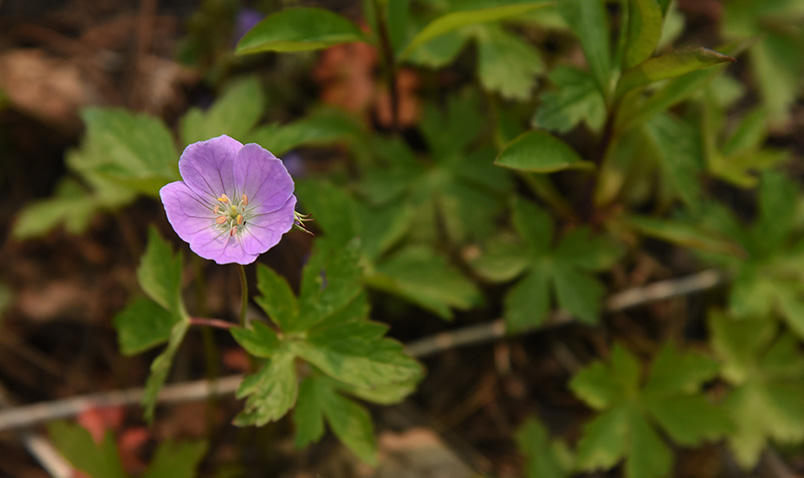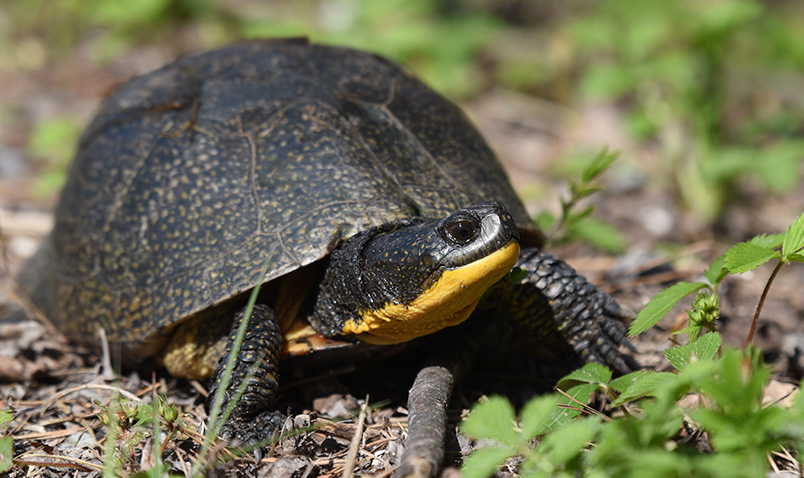
Conservation Projects
Our Conservation team regularly undertakes special projects that catalyze landscape-scale restoration or augment safe and responsible access to our myriad high-quality habitats. Informed by our strategic planning process, these high-profile projects make a significant impact on the stability, sustainability, and biotic diversity of the land, while enhancing educational opportunities and visitor experiences.
Current Projects
The Bluff Pavilion Courtyard & Gardens
In fall 2023, we embarked upon a transformational project which promises to protect the bluff as well as create a space of great beauty, tranquility, and ecological sustainability. The project reimagined how the area could better serve and delight our visitors, as well as conserve and beautify the Center. Today, the formerly grassy space at the Pavilion is a durable, multiple use courtyard, surrounded by thoughtfully designed gardens.
The Pavilion’s courtyard has been resurfaced with stone obtained from a quarry in Beaver Dam. The project will mitigate erosion run-off on the northeast corner of the space, preserving the health of the bluff – home to a remnant old growth forest in pre-European condition, one of the highest quality habitats on the Schlitz Audubon property – as well as the terrace below.
In spring 2024, we created “The Gardens,” which surround the stone courtyard. As part of our mission to conserve our land and educate visitors about our work, our conservation team designed the flowering gardens using a diverse selection of Wisconsin plant species. The Gardens will be a fine example of regional native species landscape design that is colorful, pollinator-friendly, and inviting. The team designed the gardens for color, size, fullness, and to show flowers throughout the seasons.
Learn more about our Bluff Pavilion Courtyard and Gardens
Hardwood Swamp Restoration Phase 2
A remarkable example of habitat management is providing a welcome and stunning visual change at Lake Drive and Brown Deer Road. A beautiful open mix of wetland and meadow greets visitors to the Center, thanks to removal of the dead and dying ash trees, buckthorn, and other invasive plants that had overtaken this corner of the property. Continuing restoration will further enhance the ecological significance of this habitat as it evolves into a vibrant and diverse hardwood swamp.
Thanks to a grant from the U.S. Fish & Wildlife Service, this project expands upon hardwood swamp restoration work undertaken in an adjacent project area from 2020-2022. A rare habitat type, our extended hardwood swamp will fill an important niche for a variety of plant, bird, and animal species that rely upon such specialized habitat for survival.
Learn more about the second phase of our Hardwood Swamp Restoration Project
Central Wetlands Loop Accessible Trail Project
The Central Wetlands Loop is at the heart of the Schlitz Audubon trail experience. This large trail loop is easy to find and simple to navigate, facilitating awe-inspiring outdoor experiences and plentiful educational opportunities.
The entire one-mile Central Wetlands Loop is now accessible to all, including people who use wheelchairs or other mobility devices. All trail segments are made of either crushed limestone or elevated boardwalk, and take visitors through various habitats, including woodlands, prairies, wetlands and three ponds.
Learn more about our Central Wetlands Loop Accessible Trail Project
Planned Projects

Reptile and Amphibian Habitat Preserve: Unveiling a New Habitat
This project will introduce the community to a new nature experience, as we open a segment of the property never available before to the public. The Reptile and Amphibian Habitat Preserve will enhance visitor experiences by taking hikers through land characterized by birch, large old growth sugar maples, oaks, and shagbark hickories. These additional 18 acres will not only expand hiking opportunities but will also expand the amount of land available for educational programming and citizen science.
Specifically, we will design and build a trail system through the preserve that will accentuate this unique habitat, while also respecting the habitat’s delicate breeding grounds for reptiles, amphibians, and other native animals.
West Meadows Trail Enhancement: Rediscovering the Wet Mesic Prairie
The purpose of this project is to enhance the visitor experience by taking hikers to a quieter, more remote area that also encourages wetland health and species proliferation. To do this, we will modify the trail system to respect wetlands, minimize Lake Drive traffic noise, and enhance prairie hiking experiences.
The trail enhancement, which will occur in phases, will first move trails currently in wetlands to drier upland areas, increasing usability in even wet conditions. Next, another major segment of trail will be completely rerouted to create a 19-acre area of continuous grassland habitat that will benefit several of the Center’s bird species of conservation priority, such as Bobolink and Eastern Meadowlark.
Wood Duck Pond Sedge Meadow Project: Beautifying Pond Habitat
This project will enhance the visitor experience and community education through the restoration of the sedge meadow surrounding Wood Duck Pond. This will beautify and fortify this area of the property, build and encourage Blanding’s turtle (a species of special concern) breeding habitat, as well as improve flood management in the surrounding area.
Mink Pond Project: Re-creating an Aquatic Bird Blind
This project will also enhance the visitor experience and community education through the restoration and beautification of Mink Pond, formerly Bird Blind Pond. We will relocate the bird blind to a more effective spot on the trail and restore it to a functional state. This will offer new opportunities to learn about potential species in this project area, including wood ducks, teals, and kingfishers.
Restoration will include a three-year cycle invasive management plan and the replanting of vegetation to help mitigate flooding and increase diversity. The berms surrounding Mink Pond will be rebuilt because they are disintegrating due to age and muskrat mischief. We will also ensure water flows through an existing drain to further control and mitigate stormwater.
Completed Projects
Hardwood Swamp Restoration: Phase 1
An important, yet endangered habitat, our four-acre hardwood swamp project area was an ideal location to restore this important, rare, and diverse wetland community. Phase 1 was completed in 2022.
Learn more.
Stormwater Wetland & Ravine Restoration
This significant, award-winning land project was undertaken in 2019 to dramatically reduce the impact extreme storms have on our 185-acre property. In addition to improving the quality of the stormwater flowing into Lake Michigan, the restored project area serves as a site to help educate the public on the importance of water conservation and provides high-quality habitat where native plant and animal species thrive. Learn more.